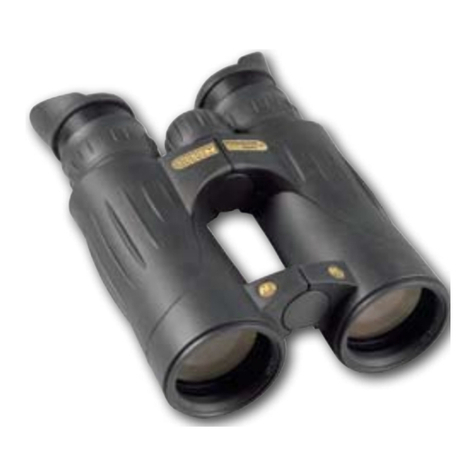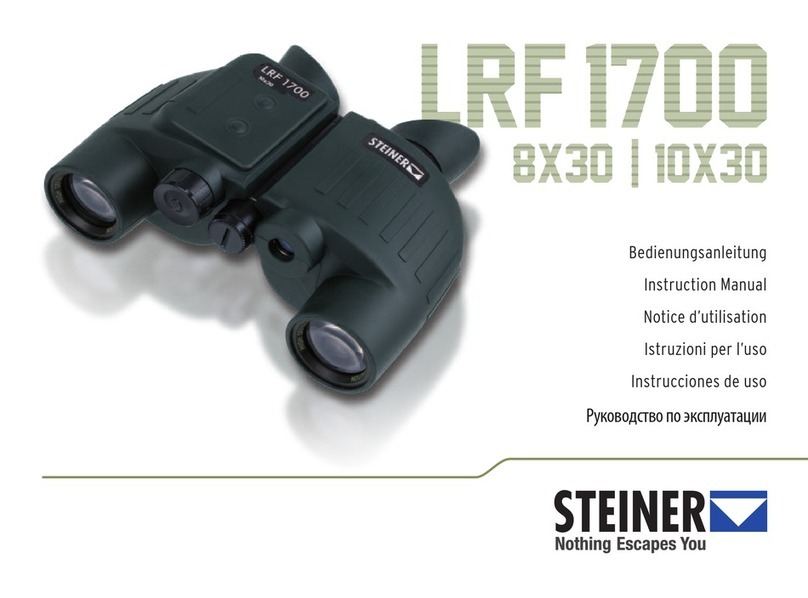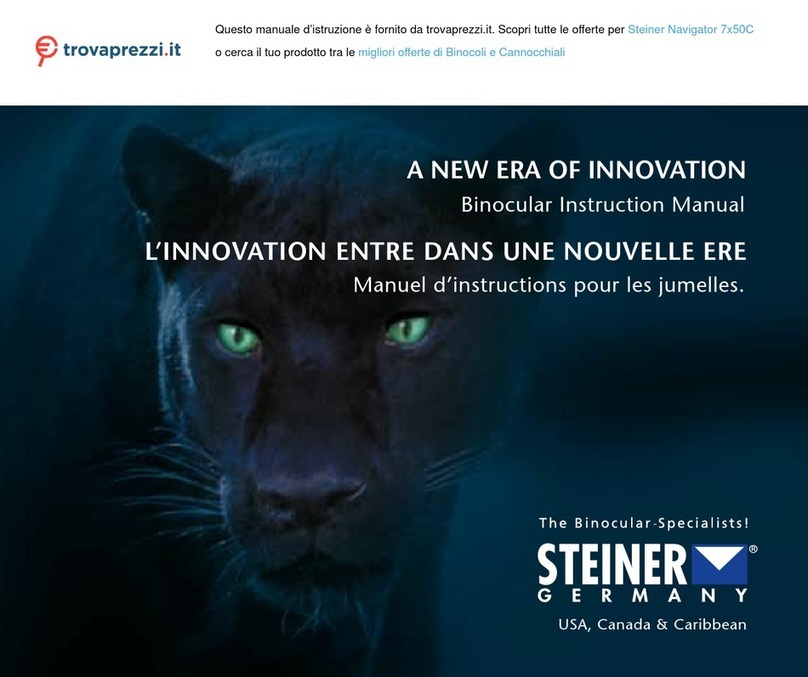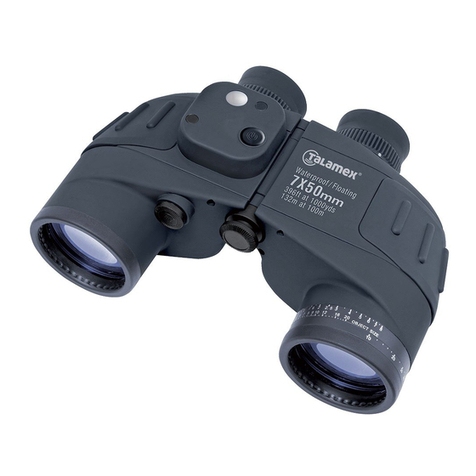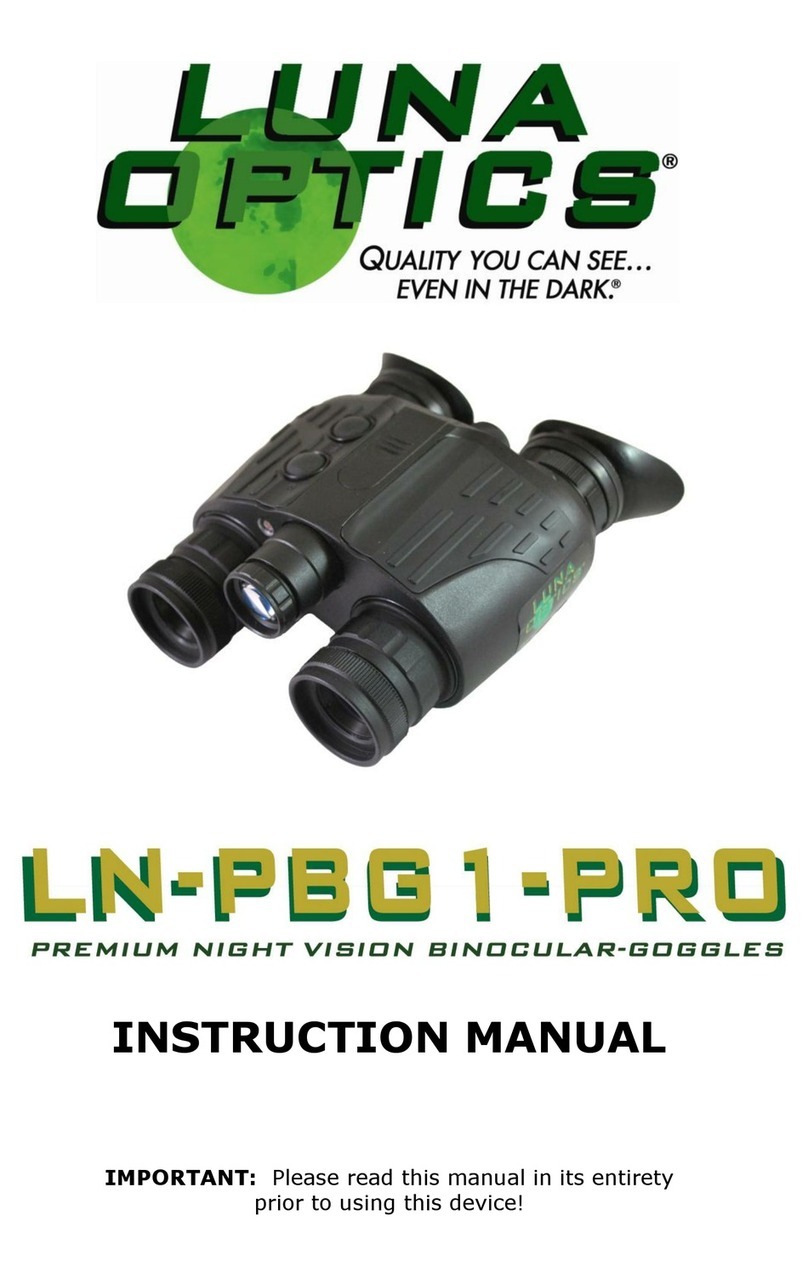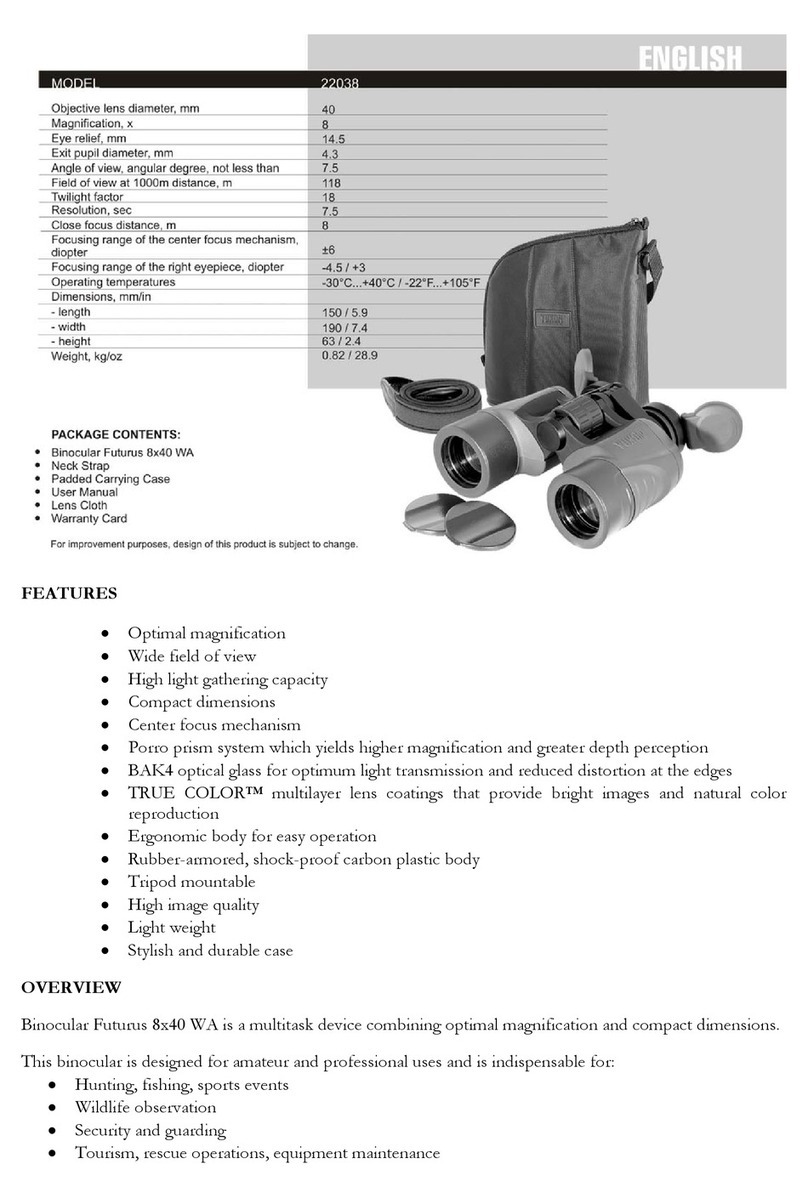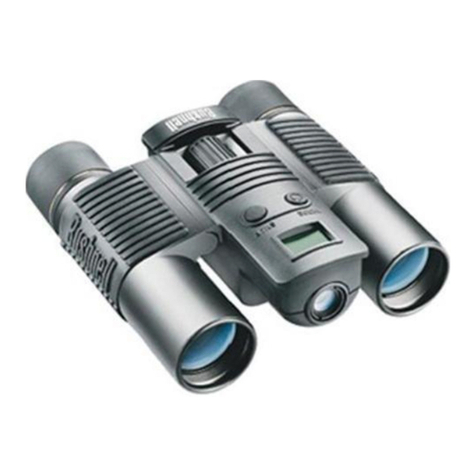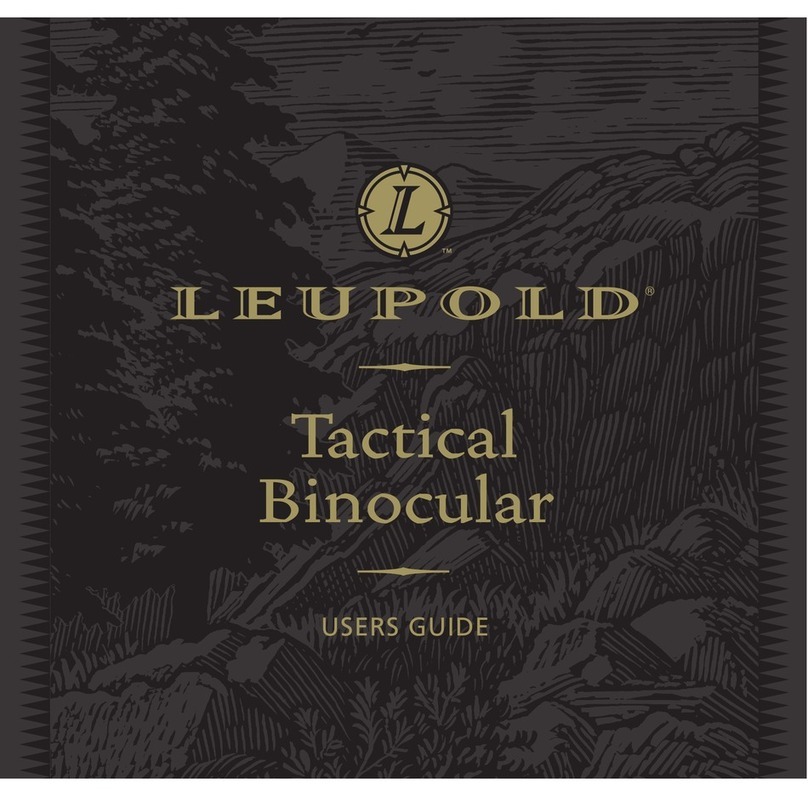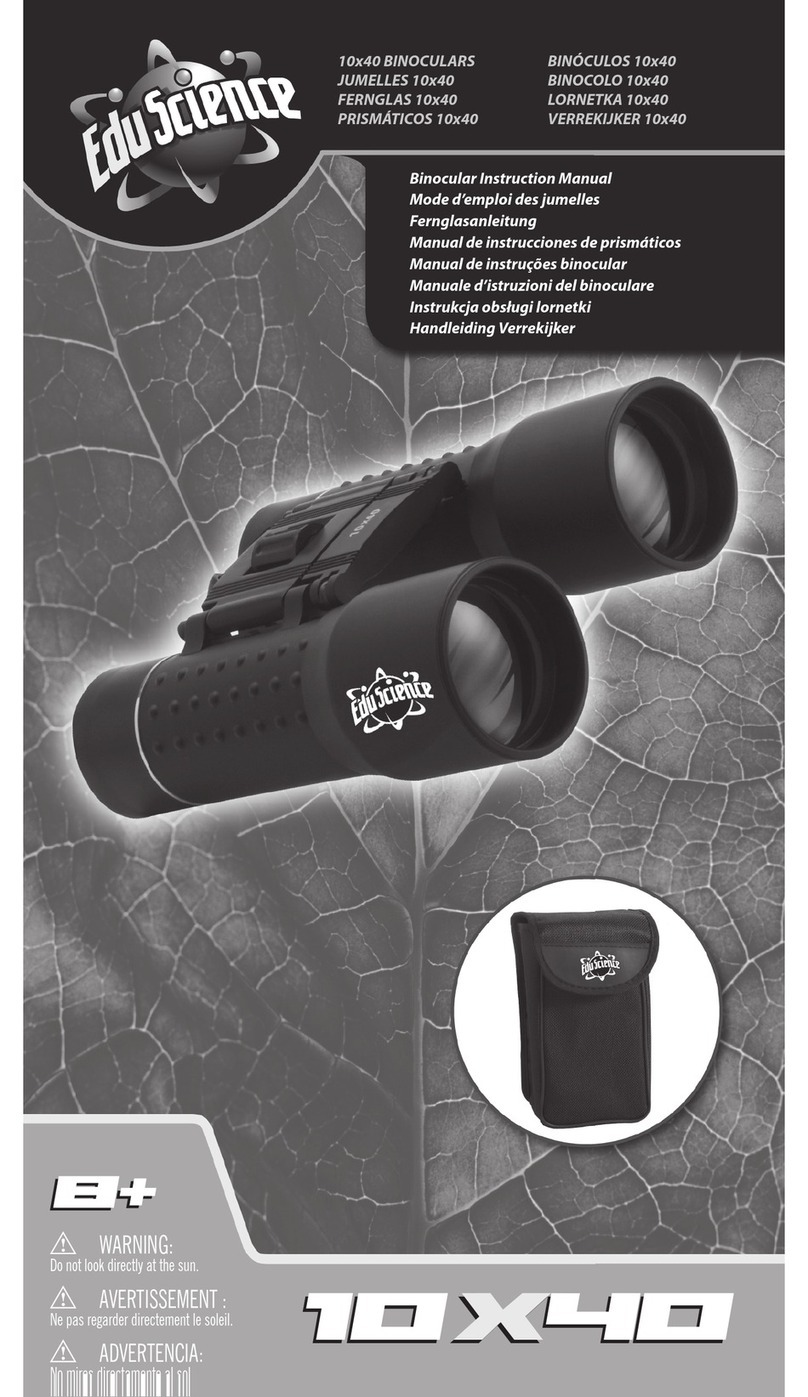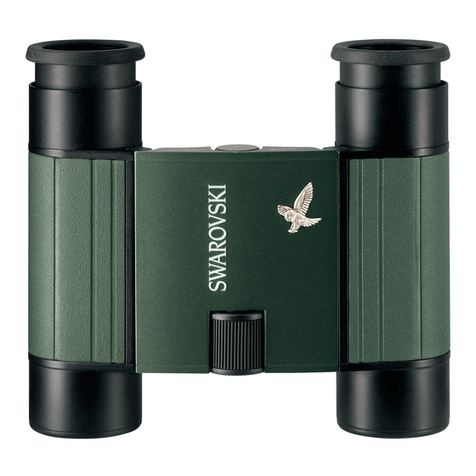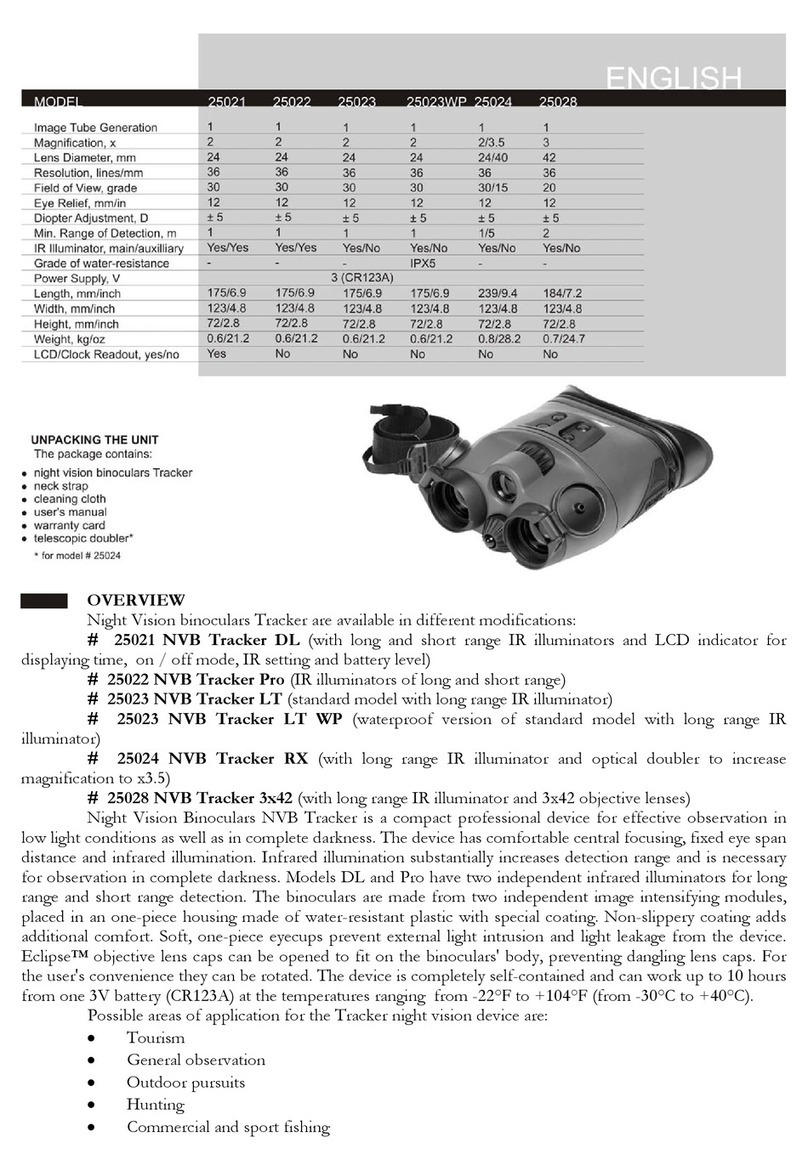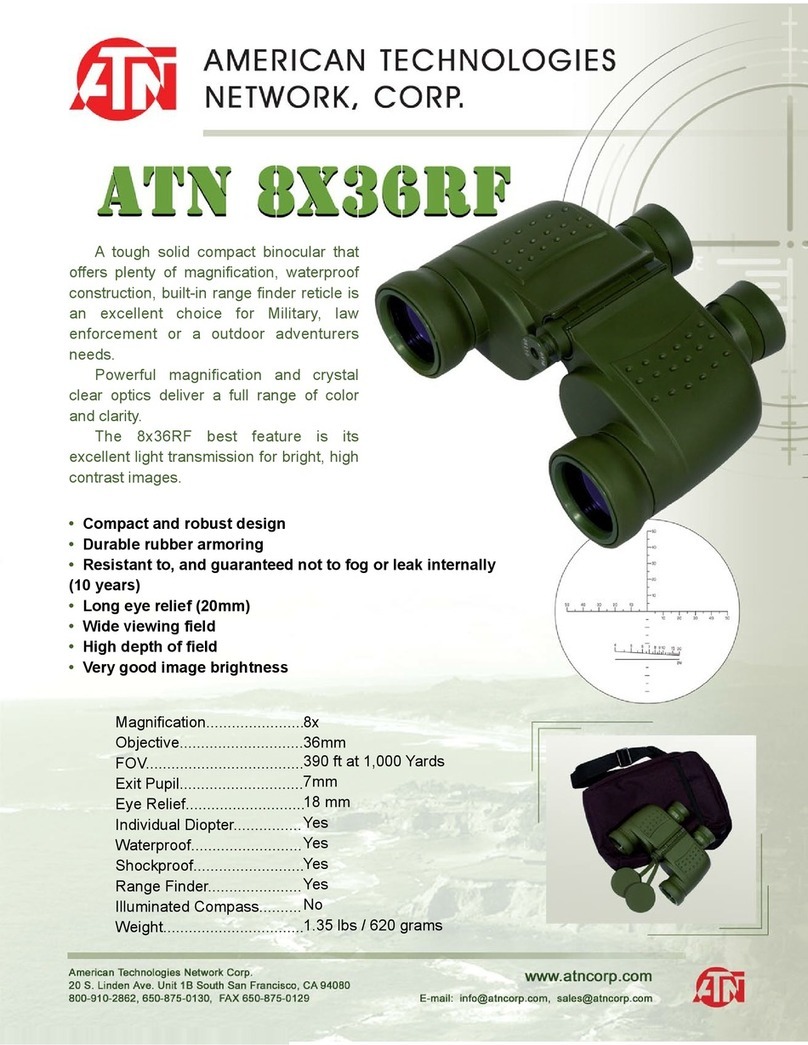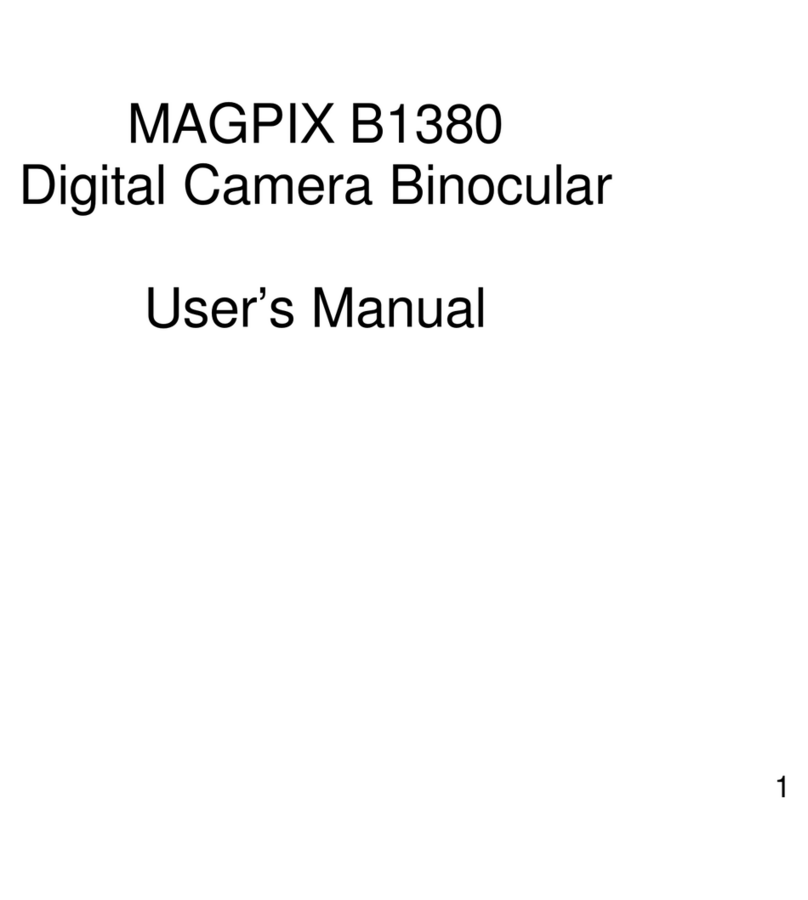Steiner P1026 User manual

Unvergessliche Momente erleben
Bedienungsanleitung
Experience unforgettable moments
Instruction Manual
Vivre des moments inoubliables
Notice d’utilisation
Vivere momenti indimenticabili
Istruzioni per l’uso
Vivir momentos inolvidables
Instrucciones de uso
Испытайте незабываемые моменты
Руководство по эксплуатации
02/2017 • Art.Nr.: V0000323 • © STEINER Optik • Photos: Klaus Andrews, KMC
Wir gratulieren Ihnen zum Kauf dieses STEINER Fernglases! Freuen Sie sich auf großartige Augenblicke.
Die im Lieferumfang enthaltenen Zubehörteile können nach Ihren Wünschen eingesetzt werden.
Eine sachgerechte Handhabung ist die Voraussetzung für jahrzehntelange Freude an diesem Präzisionsgerät.
Bitte beachten Sie deshalb vor Erstbenutzung die nachfolgenden Seiten.
Congratulations on purchasing STEINER binoculars! Do not miss your life´s defining moments! The
accessories included with your purchase may be used according to your requirements. Proper handling is a
prerequisite for enjoying this precision device over several decades. Therefore, please read the following pages before
using these STEINERs for the first time.
Nous vous félicitons de l’achat de ces jumelles STEINER ! Attendez-vous à découvrir des perspectives
grandioses. Vous pouvez utiliser les accessoires fournis à votre convenance. Pour profiter longtemps de
cet appareil de précision, il est indispensable de le manipuler correctement. Par conséquent, nous vous prions de lire
attentivement les pages suivantes avant d’utiliser les jumelles pour la première fois.
Congratulazioni, avete acquistato un binocolo STEINER! Godetevi la vista di momenti meravigliosi. Gli
accessori compresi nella fornitura possono essere utilizzati come desiderate. L’utilizzo corretto è il pre-
supposto per poter godere per decenni di questo strumento di precisione. Per questa ragione, prima di utilizzare lo
strumento per la prima volta vi preghiamo di leggere le pagine seguenti.
Le damos las gracias por la compra de unos prismáticos STEINER. Le harán disfrutar de visiones espec-
taculares. Los accesorios incluidos en el volumen de suministro pueden colocarse tal y como desee. Para
disfrutar durante décadas de este aparato de precisión, es necesario un manejo adecuado. Por ello, preste atención a
las siguientes páginas antes del primer uso.
Поздравляем Вас с приобретением бинокля STEINER! Приготовьтесь к незабываемым впечатлениям.
Входящие в комплект поставки дополнительные аксессуары Вы можете использовать по собственному усмотрению.
Правильное применение позволит Вам получать радость от работы с этим точным прибором в течение многих десятилетий.
Поэтому перед первым использованием прочитайте следующие страницы и соблюдайте приведенные там указания.
WWW.STEINER.DE
STEINER-OPTIK is a
Beretta Holding company
STEINER-OPTIK GMBH
Dr.-Hans-Frisch-Str. 9
95448 Bayreuth
Germany
Tel. +49 921 7879-15
Fax +49 921 7879-89

Unvergessliche Momente erleben
Bedienungsanleitung
Experience unforgettable moments
Instruction Manual
Vivre des moments inoubliables
Notice d’utilisation
Vivere momenti indimenticabili
Istruzioni per l’uso
Vivir momentos inolvidables
Instrucciones de uso
Испытайте незабываемые моменты
Руководство по эксплуатации
02/2017 • Art.Nr.: V0000323 • © STEINER Optik • Photos: Klaus Andrews, KMC
Wir gratulieren Ihnen zum Kauf dieses STEINER Fernglases! Freuen Sie sich auf großartige Augenblicke.
Die im Lieferumfang enthaltenen Zubehörteile können nach Ihren Wünschen eingesetzt werden.
Eine sachgerechte Handhabung ist die Voraussetzung für jahrzehntelange Freude an diesem Präzisionsgerät.
Bitte beachten Sie deshalb vor Erstbenutzung die nachfolgenden Seiten.
Congratulations on purchasing STEINER binoculars! Do not miss your life´s defining moments! The
accessories included with your purchase may be used according to your requirements. Proper handling is a
prerequisite for enjoying this precision device over several decades. Therefore, please read the following pages before
using these STEINERs for the first time.
Nous vous félicitons de l’achat de ces jumelles STEINER ! Attendez-vous à découvrir des perspectives
grandioses. Vous pouvez utiliser les accessoires fournis à votre convenance. Pour profiter longtemps de
cet appareil de précision, il est indispensable de le manipuler correctement. Par conséquent, nous vous prions de lire
attentivement les pages suivantes avant d’utiliser les jumelles pour la première fois.
Congratulazioni, avete acquistato un binocolo STEINER! Godetevi la vista di momenti meravigliosi. Gli
accessori compresi nella fornitura possono essere utilizzati come desiderate. L’utilizzo corretto è il pre-
supposto per poter godere per decenni di questo strumento di precisione. Per questa ragione, prima di utilizzare lo
strumento per la prima volta vi preghiamo di leggere le pagine seguenti.
Le damos las gracias por la compra de unos prismáticos STEINER. Le harán disfrutar de visiones espec-
taculares. Los accesorios incluidos en el volumen de suministro pueden colocarse tal y como desee. Para
disfrutar durante décadas de este aparato de precisión, es necesario un manejo adecuado. Por ello, preste atención a
las siguientes páginas antes del primer uso.
Поздравляем Вас с приобретением бинокля STEINER! Приготовьтесь к незабываемым впечатлениям.
Входящие в комплект поставки дополнительные аксессуары Вы можете использовать по собственному усмотрению.
Правильное применение позволит Вам получать радость от работы с этим точным прибором в течение многих десятилетий.
Поэтому перед первым использованием прочитайте следующие страницы и соблюдайте приведенные там указания.
WWW.STEINER.DE
STEINER-OPTIK is a
Beretta Holding company
STEINER-OPTIK GMBH
Dr.-Hans-Frisch-Str. 9
95448 Bayreuth
Germany
Tel. +49 921 7879-15
Fax +49 921 7879-89

Porro-Modelle
Porro models
Prismes de porro
Modelli con prisma
di Porro
Modelos de Porro
Модели с призмой Порро
2
3
1
4
A
Dachkant-Modelle
Roof models
Prismes en toit
Modelli con prisma retto
Modelos de Techo
Модели с призмой Roof
B
4
3
2
1
Legende / Key / Légende / Legenda / Leyenda / Пояснения
Erläuterung Porro-Modelle / Explanation for the Porro models / Explication des Prismes de porro / Spiegazione
dei modelli con prisma di Porro / Descripción de los modelos de Porro / Пояснения к моделям с призмой Порро
1Okular mit Augenmuschel, Ocular with eyecup, Oculaire à œillère, Oculare con conchiglia oculare,
Ocular con tapón ocular, Окуляр с наглазником
2Dioptrienausgleich, Dioptre setting, Correction dioptrique, Regolazione diottrica, Compensador de dioptrías,
Корректор диоптрий
3Fokussierrad, Focussing wheel, Molette de mise au point, Ghiera di messa a fuoco, Rueda de enfoque,
Фокусировочный маховичок
4Objektiv, Objective, Objectif, Obiettivo, Objetivo, Объектив
Erläuterung Dachkant-Modelle / Explanation for the roof models / Explication des modèles Prismes en toit /
Spiegazione dei modelli con prisma retto / Descripción de los modelos de Techo /
Пояснения к моделям с призмой Roof
1Okular mit Augenmuschel, Ocular with eyecup, Oculaire à œillère, Oculare con conchiglia oculare,
Ocular con tapón ocular, Окуляр с наглазником
2Dioptrienausgleich, Dioptre setting, Correction dioptrique, Regolazione diottrica, Compensador de dioptrías,
Корректор диоптрий
3Fokussierrad, Focussing wheel, Molette de mise au point, Ghiera di messa a fuoco, Rueda de enfoque,
Фокусировочный маховичок
4Objektiv, Objective, Objectif, Obiettivo, Objetivo, Объектив
47

Porro-Modelle
Porro models
Prismes de porro
Modelli con prisma
di Porro
Modelos de Porro
Модели с призмой Порро
2
3
1
4
A
Dachkant-Modelle
Roof models
Prismes en toit
Modelli con prisma retto
Modelos de Techo
Модели с призмой Roof
B
4
3
2
1
Legende / Key / Légende / Legenda / Leyenda / Пояснения
Erläuterung Porro-Modelle / Explanation for the Porro models / Explication des Prismes de porro / Spiegazione
dei modelli con prisma di Porro / Descripción de los modelos de Porro / Пояснения к моделям с призмой Порро
1Okular mit Augenmuschel, Ocular with eyecup, Oculaire à œillère, Oculare con conchiglia oculare,
Ocular con tapón ocular, Окуляр с наглазником
2Dioptrienausgleich, Dioptre setting, Correction dioptrique, Regolazione diottrica, Compensador de dioptrías,
Корректор диоптрий
3Fokussierrad, Focussing wheel, Molette de mise au point, Ghiera di messa a fuoco, Rueda de enfoque,
Фокусировочный маховичок
4Objektiv, Objective, Objectif, Obiettivo, Objetivo, Объектив
Erläuterung Dachkant-Modelle / Explanation for the roof models / Explication des modèles Prismes en toit /
Spiegazione dei modelli con prisma retto / Descripción de los modelos de Techo /
Пояснения к моделям с призмой Roof
1Okular mit Augenmuschel, Ocular with eyecup, Oculaire à œillère, Oculare con conchiglia oculare,
Ocular con tapón ocular, Окуляр с наглазником
2Dioptrienausgleich, Dioptre setting, Correction dioptrique, Regolazione diottrica, Compensador de dioptrías,
Корректор диоптрий
3Fokussierrad, Focussing wheel, Molette de mise au point, Ghiera di messa a fuoco, Rueda de enfoque,
Фокусировочный маховичок
4Objektiv, Objective, Objectif, Obiettivo, Objetivo, Объектив
47

3
Grundlagen zur Bedienung
22
33
44
55
11
66
Anbringen der Gurthalterung:
Mit ClicLoc-System:
Zum Lösen des Tragegurtes üben Sie auf die markierte Stelle der Gummiarmierung einen Druck
aus, um den Verschluss zu entriegeln
11
. Nun kann der Schnappverschluss abgezogen bzw.
eingeführt werden. Die Nase des Schnappverschlusses zeigt immer nach außen und muss
beim Einführen hörbar einrasten.
Ohne ClicLoc-System:
Bitte lösen Sie ein Ende des Gurtes aus der Schiebeschleife und führen dieses von oben durch die
Fernglas-Öse.
22
Anschließend den Tragegurt wieder zurück in die Schiebeschlaufe ziehen
und den Gurt durch Ziehen straffen. Das zweite Gurtende wird identisch befestigt.
Befestigung von Neoprenschutzhülle und Regenschutzdeckel:
Ihrem Fernglas können verschiedene Regenschutz-Systeme beiliegen, die am Tragegurt be-
festigt werden. Bei Neoprenschutzhüllen achten Sie bitte darauf, dass der halbrunde
Ausschnitt der Kappe über dem Fokussierrad
33
liegt. Bei Regenschutzdeckeln kann die
Gurthalterung seitlich an den hierfür vorgesehenen Ösen eingefädelt werden
44
.
Befestigung von Objektivschutzkappen:
Ist Ihr Fernglas mit ClicLoc Objektivschutzkappen zum Stecken ausgestattet, drücken Sie
zum Lösen der Kappen kurz auf die sichtbare Vertiefung und ziehen die Kappe aus ihrer
Halterung
55
.Zum Wiederanstecken schieben Sie die Schnappverbindung zurück in die
Halterung, bis sie sicher und hörbar einrastet. Hierbei zeigt die Nase des Schnappverschlusses
immer nach außen. Objektivschutzkappen, die an der Mittelachsebefestigt sind, ziehen Sie
zum Entfernen über die Mittelachse
66
.
DE

4
Grundlagen zur Bedienung
88
99
1010
1111
1212
77
Anpassung von Augenabstand und Augenmuscheln:
Augenabstand anpassen:
Durch Abknicken des Fernglases über die Mittelachse wird der persönliche Augenabstand justiert,
so dass Sie ein rundes Bild sehen können.
Um den optimalen Blick durch ihr STEINER-Fernglas zu gewährleisten,
können die Augenmuscheln in verschiedene Stellungen gebracht werden:
Augenmuscheln einstellen (Modelle mit ErgoFlex und Ergonomischen Augenmuscheln):
ergonomisch
77
, zylindrisch
88
, oder für Brillenträger
99
.
Augenmuscheln einstellen (Modelle mit zylindrischen Augenmuscheln):
zylindrisch
88
, oder für Brillenträger
99
.
Augenmuscheln einstellen (Modelle mit Drehaugenmuscheln):
ergonomisch
1010
, zylindrisch
1111
, oder für Brillenträger
1212
.
Fokussierung:
Porro-Fernglas mit Sports-Auto-Focus (siehe auch Legende):
Den Dioptrieausgleich auf beiden Seiten auf „0“ stellen und immer scharf sehen – von ca. 20 m
bis unendlich. Ist dies nicht der Fall, liegt eine Fehlsichtigkeit eines oder beider Augen vor,
die angepasst werden muss.
1. Wählen Sie ein möglichst detailreiches, weit entferntes Objekt (Distanz ca. 200 Meter).
2. Verdecken Sie das linke Objektiv mit der Hand oder der Objektivschutzkappe und sehen
Sie durch Ihr Fernglas.
3. Drehen Sie nun den Dioptrienausgleich am rechten Okular, bis das Auge völlig klar und
scharf sieht.
4. Wiederholen Sie den Vorgang für das linke Auge. Nun sehen Sie ab 20 Meter immer scharf.

5
Grundlagen zur Bedienung
1414
1313
Porro-Fernglas mit Sports-Auto-Focus PLUS:
Ist die individuelle Sehschärfe eingestellt (siehe Sports-Auto-Focus), haben Sie beim Sports-
Auto-Focus PLUS zusätzlich die Möglichkeit, Objekte im Nahbereich (ab 2m Entfernung),
durch eine kurze Bewegung am Fokussierrad
1313
scharfzustellen.
Dachkant-Fernglas mit Fast-Close-Focus (siehe auch Legende):
1. Wählen Sie ein möglichst detailreiches, weitentferntes Objekt (Distanz ca. 200 Meter).
2. Verdecken Sie das linke Objektiv mit der Hand oder der eventuell beigefügten Objektiv-
schutzkappe und sehen Sie durch Ihr Fernglas.
3. Drehen Sie nun das Fokussierrad, bis das rechte Auge völlig klar und scharf sieht.
4. Zum Einstellen der linken Fernglashälfte verdecken Sie das rechte Objektiv und sehen Sie
durch Ihr Fernglas. Dann drehen Sie den Dioptrienausgleich am linken Okular, bis Sie das
gleiche Objekt scharf sehen.
5. Durch Drehen am Fokussierrad lässt sich das Fernglas nun auf Entfernungen für beide Augen
scharf stellen und liefert überragend scharfe und brillante Bilder.
Hinweis: Bei den Discovery Modellen finden Sie den Dioptrienausgleich auf beiden Okularen.
Kompasseinstellungen:
Kompassbeleuchtung:
Bei STEINER-Marine-Ferngläsern mit eingebautem Kompass befindet sich an der Seite des
Kompassgehäuses ein Knopf
1414
, mit dem Sie die Kompassanzeige im Okular bei Dunkelheit
beleuchten können. Dazu müssen Sie nur den entsprechenden Knopf gedrückt halten. Um
den Kompass auch in der Nacht verwenden zu können,ist die Kompassbeleuchtung mit
einer Batterie ausgestattet.
DE

6
Grundlagen zur Bedienung
1616
1515
1717
Batteriewechsel:
Zum Wechseln gehen Sie wie folgt vor:
Öffnen Sie das Batteriefach
1515
. Wechseln Sie nun die verbrauchte(n) Batterie(n) aus und
beachten Sie hierbei die korrekte Zuordnung des Plus- bzw. Minus-Pols. Achten Sie beim
Verschließen des Batteriefachs darauf, dieses fest zu verschließen, um ein Eindringen
von Wasser zu verhindern.
Umweltschutz: Entsorgen Sie leere Batterien nicht über Ihren Haushaltsabfall
1616
. Infor-
mieren Sie sich über die geltenden Bestimmungen zur getrennten Sammlung von Elektro-
und Elektronik-Altgeräten.
Produkte mit integrierter Präzisionsstrichplatte:
Sie ist sehr gut sichtbar
1717
und liefert Messungen in Meter oder foot (0,33 m).
Messbeispiel:
Ein 10 m hohes Boot kreuzt Ihren Kurs.
Auf der Zahlenskala der Strichplatte liest
man den Wert 20 ab. Die zu berechnende
Entfernung ergibt sich aus der tatsäch-
lichen Größe, in unserem Beispiel 10 m,
geteilt durch die abgelesene Größe, in un-
serem Beispiel 20 m, mal 1000. 10 m / 20 =
0,5 x 1000 = 500 m. Das Schiff ist also
500 m entfernt.
Formel zur Benutzung der Mess-Skala:
Entfernung: tatsächliche Größe (z.B.10 m)
abgelesene Größe (z.B.20 m) x 1000 oder
Wirkliche Größe: Entfernung x abgelesene Größe
1000
1 nautische Meile = 1,852 km

7
Pflege, Reinigung und Hinweise
2121
2020
1919
1818
Reinigung/Pflege und wichtige Produkthinweise:
Reinigung Ihres Fernglases:
Entfernen Sie Staub und losen Schmutz auf den Linsen mit einem Pinsel. Danach benutzen
Sie zum Abwischen der Linsen ausschließlich ein weiches, evtl. feuchtes Tuch, sonst können
Kratzer entstehen. Wischen Sie Salzwasser mit einem feuchten Tuch ab – reiben Sie anschlie-
ßend die Optik mit einem Tuch trocken.
Pflege der Gummiarmierung:
Druckwasserdichte Ferngläser können mit Flüssigseife und unter fließendem Wasser ab-
gespült werden. Um kleinere Haarrisse zu schließen, die durch UV-Strahlung entstehen
können, sollte die Gummiarmierung mit Cockpit-Spray oder Nigrin-Kunststoffpflege behan-
delt werden.
Produkt-Seriennummer:
Jedes STEINER-Fernglas verfügt über eine eigene Seriennummer.Sie erlaubt den
Rückschluss auf das Produktionsdatum. Auch kann Ihr Fernglas (nach erfolgter Registrierung
auf der STEINER Website) bei Verlust oder Diebstahl identifiziert werden. Die Seriennummer
Ihres Fernglases (modellabhängig) finden Sie am vorderen Ende der Fernglas-Achse, zwi-
schen den Objektiven
1818
, auf der Fernglas-Achsen Unterseite
1919
oder in der Objektivlinse
2020
.
Wichtiger Sicherheitshinweis:
Blicken Sie mit dem Fernglas niemals direkt in die Sonne
2121
! Dies kann zu schweren Augen-
schäden, möglicherweise auch zur Erblindung führen!
DE

Customer-Service Deutschland:
Tel.: +49 921 7879-15
E-Mail: customer-service@steiner.de
Customer-Service International:
Tel.: +49 921 7879-851
E-Mail: customer-service-international@steiner.de
STOEGER CANADA (1990) LTD
1801 Wentworth St. Unit #1
Whitby, Ontario L1N 8R6
Canada
Tel.: 905-436-9077
E-Mail: info@stoegercanada.ca
www.stoegercanada.ca
STEINER Nordamerika:
Vertriebspartner
Burris Company Inc.
331 East 8th Street
Greeley, CO 80631
USA
Tel.: +1-970-356/1670
E-Mail: info@steiner-binoculars.com
www.steiner-binoculars.com
Weitere Informationen
zum Unternehmen
finden Sie unter:
www.steiner.de
8
Sicherheitshinweis und Kontakt
Bitte haben Sie Verständnis dafür, dass wir für Verschleißteile wie Gummiarmierungen, Trageriemen,
Augenmuscheln oder Schutzkappen keine Garantie geben können.
Wenn Sie Probleme bei der Benutzung Ihres Fernglases haben, wenden Sie sich entweder an einen
Fachhänder Ihres Vertrauens oder kontaktieren Sie unseren
Customer-Service-National
unter der Telefon-Nummer: +49 921 7879-15.
STEINER-OPTIK GmbH
Dr.-Hans-Frisch-Str. 9
D-95448 Bayreuth
Germany
www.steiner.de

Experience unforgettable moments
Instruction Manual

10
Basic instructions for use
22
33
44
55
11
66
Attaching the belt attachment:
With ClicLoc System:
To loosen the carrying strap and unlatch the lock, press and hold the marked oval position on the
rubber armouring
11
. The snap fit can now be pulled off and/or inserted. Make sure that the
catch is always facing outwards and that it audibly engages while being inserted.
Without ClicLoc system:
Please loosen one end of the strap from the side loop and feed the strap from the top through
the eyelet.
22
Now pull the carrying strap through the slide loop again and pull firmly on the
strap to tighten it. Repeat these steps to fasten the other end of the strap in the same way.
Attaching the neoprene protection cover and the rain protection cover:
Several rain protection systems may be enclosed with your binoculars that are attached to the
carrying strap. For neoprene protection covers, please ensure that the semicircular opening
on the cover is placed over the focussing wheel
33
.For rain protection covers, the strap
retainer may be threaded laterally through the open eyelet
44
provided for this purpose.
Attaching the objective protection covers:
If your binoculars are equipped with locking ClicLoc objective protection covers, press on the
visible depression to release the cover and pull it out of its retainer
55
.To re-connect it, push
the snap-on fastener back into the retainer until it is secure and audibly engages. Objective
protection covers that are attached to the centre axis are removed by pulling them over the
centre axis
66
.

11
Basic instructions for use
88
99
1010
1111
1212
77
Adjusting the interocular distance and the eyecups:
Adjusting the interocular distance:
To adjust an individual interocular distance turn the two halves of the binoculars via the centre
axis until you can see a round image.
To ensure optimum visibility through your STEINERS, the eyecups may be set to different
positions:
Adjusting the eyecups (models with ErgoFlex and ergonomic eyecups):
ergonomic
77
, cylindrical
88
or for persons wearing glasses
99
.
Adjusting the eyecups (models with cylindrical eyecups):
cylindrical
88
or for persons wearing glasses
99
.
Adjusting the eyecups (models with twist-up eyecups):
ergonomic
77
, cylindrical
88
or for persons wearing glasses
99
.
Focussing:
Porro binoculars with Sports-Auto-Focus (see also key):
Adjust both dioptre settings to “0” and everything from approx. 20m and beyond is always sharp
and clear. If this is not the case, one or both eyes may be ametropic. This has to be adjusted.
1. Choose a very detailed and remote object (approx. 200m distant).
2. Cover the left objective with your hand or the objective protection cover and look through
the binoculars.
3. Now turn the dioptre setting on the right ocular until you can see an entirely sharp and clear
image with your right eye.
4. Please repeat the same steps for the left eye. Now everything from 20m and beyond is
always sharp and clear.
GB

12
Basic instructions for use
1414
1313
Porro binoculars with Sports-Auto-Focus PLUS:
Once set to the individual acuity (see Sports-Auto-Focus), Sports-Auto-Focus PLUS also of-
fers you the possibility to focus objects close by (from a distance of 2m) by means of a short
turn on the focussing wheel
1313
.
Roof binoculars with Fast-Close-Focus (see key also):
1. Choose a very detailed and remote object (approx. 200m distant).
2. Cover the left objective with your hand, or the objective protection cover if enclosed, and
look through the binoculars.
3. Now turn the focussing wheel until you can see an entirely sharp and clear image with
your right eye.
4. To adjust the left eye of the binoculars, cover the right objective and look through your
binoculars. Then turn the dioptre setting on the left ocular until you see a sharp and clear
image of the same object.
5. By turning the focusing wheel, it is now possible to focus the binoculars down to different
distances giving outstandingly detailed and brilliant images.
Note: in the Discovery series you will find the dioptre setting on both oculars.
Compass settings:
Compass light:
For STEINER marine binoculars equipped with an integrated compass, you will find a button
1414
on the side of the compass housing to illuminate the compass display inside the ocular in the
dark. To do so, simply press and hold the corresponding button. In order to use the compass at
night the compass light is equipped with a battery.

13
Basic instructions for use
1616
1515
1717
Changing batteries:
To be able to also use the compass at night, the compass light is equipped with a battery.
Proceed as follows to change the battery:
Open the battery case
1515
. Now replace used battery/batteries and be careful to correctly
assign the positive and/or negative pole terminals. When closing the battery cover, make
sure that you close it tightly to prevent water from penetrating into the battery compartment.
Environmental protection: Batteries must not be disposed of with household waste
1616
.
Obtain information about the applicable regulations for the collection of WEEE (Waste of
Electrical and Electronic Equipment) in your country.
Products with integrated precision reticle:
It is highly visible
1717
and gives measurements in metres or feet (0.33m).
Measurement example:
A boat with a height of 10m is intersecting
your course. You read the value 20 from
the number scale of the reticle. The dis-
tance to be calculated is the actual size, 10
m in our example, divided by the read size,
20 m in our example, multiplied by 1000.
10 m / 20 = 0.5 x 1000 = 500 m. Thus, the
ship is 500 m away.
Formula to use the measurement scale:
Distance: Actual size (e.g.10m)
Read size (e.g. 20m) x 1000 or
Actual size: Distance x read size
1000
1 nautical mile = 1.852km
GB

14
Maintenance, Cleaning and Notes
2121
2020
1919
1818
Cleaning/Maintenance and Important Product Information:
Cleaning your binoculars:
Remove dust and loose dirt on the lenses with a brush. Then use only a soft, possibly damp cloth
to wipe the lenses. Failure to use a soft cloth can scratch the lenses. Wipe off salt water with a
damp cloth then use a dry cloth to wipe the lenses.
Care for the rubber armouring:
Binoculars resistant to water pressure may be rinsed under running water using liquid soap.
To close smaller hairline cracks that may be caused by UV radiation the rubber armouring
should be treated with Cockpit Spray or Nigrin Plastic Care.
Product Serial Number:
All STEINERs have their own serial number. This allows you to ascertain when your binoculars
were produced and it also provides a way (following the registration on the STEINER website)
to identify them in case of loss or theft. You can find the serial number of your binoculars
(depending on the model) at the front end of the binoculars’ axis, between the objectives
1818
,
on the underside of the binoculars’ axis
1919
or in the objective lens
2020
.
Important Safety Note:
Never look directly into the sun with your binoculars
2121
! This may cause serious damage to
your eyes and possibly lead to blindness!

15
Safety Note and Contact
Please understand that we cannot accept warranty claims for wear parts such as rubber armouring,
carrying straps, eyecups or protective caps. Should you encounter any problems while using your
binoculars please contact your specialised dealer or our
national customer service at: +49 921 7879-851.
Customer service Germany:
Phone: +49 921 7879-15
Email: customer-service@steiner.de
Customer-Service International:
Phone: +49 921 7879-851
E-Mail: customer-service-international@steiner.de
STEINER-OPTIK GmbH
Dr.-Hans-Frisch-Str. 9
D-95448 Bayreuth
Germany
www.steiner.de
STEINER North America:
Distribution Partner
Burris Company Inc.
331 East 8th Street
Greeley, CO 80631
USA
Phone: +1-970-356/1670
E-Mail: info@steiner-binoculars.com
www.steiner-binoculars.com
STOEGER CANADA (1990) LTD
1801 Wentworth St. Unit #1
Whitby, Ontario L1N 8R6
Canada
Phone: 905-436-9077
E-Mail: info@stoegercanada.ca
www.stoegercanada.ca
Should you require further
information about the
company, please visit:
www.steiner.de
GB

Vivre des moments inoubliables
Notice d’utilisation

17
Principes d’utilisation
22
33
44
55
11
66
Fixation du support de sangle :
Avec le système ClicLoc :
Pour défaire la sangle de transport, appuyez sur le poinçon indiqué sur la gaîne caoutchouc
11
.
La fermeture est alors déverrouillée. Vous pouvez à présent retirer la fermeture à clip ou
l’introduire. L’ergot de la fermeture à clip doit toujours être tourné vers l’extérieur et faire un
clic audible lorsqu’il est inséré.
Sans le système ClicLoc :
Retirez une extrémité de la sangle de la boucle coulissante, puis faites-la passer à travers l’œillet
des jumelles
22
par le haut. Glissez ensuite de nouveau la sangle de transport dans la boucle
coulissante et serrez-la en tirant. Fixez la deuxième extrémité de la sangle de la même manière.
Fixation de la housse de protection néoprène et du capuchon anti-pluie :
Vos jumelles peuvent être fournies avec différents systèmes anti-pluie qui se fixent sur la
sangle de transport. Lorsque vous utilisez des housses de protection néoprène, veillez à ce
que la section semi-circulaire du capuchon se trouve au-dessus de la molette de mise au
point
33
. Dans le cas des capuchons anti-pluie, le support de sangle peut être enfilé sur le
côté à travers l’œillet prévu à cet effet
44
.
Fixation des caches d’objectifs :
Si vos jumelles sont équipées des caches d’objectifs ClicLoc à emboîter, appuyez brièvement
sur le creux visible pour défaire les caches puis ôtez-les de leur support
55
.Pour les remboî-
ter, glissez de nouveau la fermeture à clip dans le support jusqu’à ce qu’elle s’enclenche en
faisant un clic audible. Retirez les caches d’objectifs fixés sur l’axe central en les faisant passer
par-dessus l’axe central
66
.
FR

18
Principes d’utilisation
88
99
1010
1111
1212
77
Ajustement de la distance interpupillaire et des œillères :
Ajustement de la distance interpupillaire :
Votre distance entre les yeux se règle par articulation de l’axe central afin que vous voyiez une
image ronde.
Pour garantir une vision parfaite avec vos jumelles STEINER, les œillères peuvent être
réglées dans différentes positions :
Réglage des œillères (modèles à ErgoFlex et œillères ergonomiques) :
Ergonomique
77
, cylindrique
88
, ou pour porteurs de lunettes
99
.
Réglage des œillères (modèles à œillères cylindriques) :
Cylindrique
88
, ou pour porteurs de lunettes
99
.
Réglage des œillères (modèles à œillères rotatives) :
Ergonomique
77
, cylindrique
88
, ou pour porteurs de lunettes
99
.
Mise au point :
Jumelles Porro à Sports-Auto-Focus (voir légende) :
Réglez les deux corrections dioptriques sur « 0 » et veillez à toujours avoir une vision nette,
de 20 m environ à l’infini. Si ce n’est pas le cas, vous avez une déficience visuelle à un œil ou
aux deux yeux qui doit être corrigée.
1.
Choisissez un objet éloigné avec le plus de détails possible (à une distance de 200 mètres environ).
2. Cachez l’objectif gauche avec votre main ou le cache d’objectif et regardez à travers vos jumelles.
3. Tournez maintenant le correction dioptrique sur l’oculaire droit jusqu’à ce que votre œil ait
une vision parfaitement claire et nette.
4. Répétez la procédure pour l’œil gauche. À présent, votre vision est toujours nette à partir
d’une distance de 20 mètres.
Table of contents
Languages:
Other Steiner Binoculars manuals
